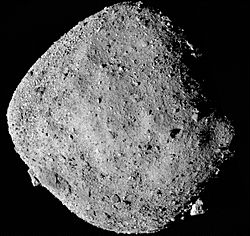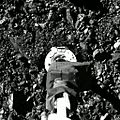101955 Bennu facts for kids

Mosaic image of Bennu consisting of 12 PolyCam images collected on 2 December 2018 by OSIRIS-REx from a range of 24 km (15 mi).
|
|||||||||||||||||
| Discovery | |||||||||||||||||
|---|---|---|---|---|---|---|---|---|---|---|---|---|---|---|---|---|---|
| Discovered by | LINEAR | ||||||||||||||||
| Discovery site | Lincoln Lab's ETS | ||||||||||||||||
| Discovery date | 11 September 1999 | ||||||||||||||||
| Designations | |||||||||||||||||
| MPC designation | (101955) Bennu | ||||||||||||||||
|
Named after
|
Bennu | ||||||||||||||||
| 1999 RQ36 | |||||||||||||||||
| Apollo · NEO · PHA · risk listed | |||||||||||||||||
| Orbital characteristics | |||||||||||||||||
| Epoch 1 January 2011 (JD 2455562.5 ) | |||||||||||||||||
| Uncertainty parameter 0 | |||||||||||||||||
| Observation arc | 21.06 yr (7693 days) | ||||||||||||||||
| Aphelion | 1.3559 au (202.84 Gm) | ||||||||||||||||
| Perihelion | 0.89689 au (134.173 Gm) | ||||||||||||||||
| 1.1264 au (168.51 Gm) | |||||||||||||||||
| Eccentricity | 0.20375 | ||||||||||||||||
| 1.1955 yr (436.65 d) | |||||||||||||||||
|
Average orbital speed
|
28.0 km/s (63,000 mph) | ||||||||||||||||
| 101.7039° | |||||||||||||||||
|
Mean motion
|
0° 49m 28.056s / day | ||||||||||||||||
| Inclination | 6.0349° | ||||||||||||||||
| 2.0609° | |||||||||||||||||
| 66.2231° | |||||||||||||||||
| Earth MOID | 0.0032228 au (482,120 km) | ||||||||||||||||
| Venus MOID | 0.194 au (29,000,000 km) | ||||||||||||||||
| Mars MOID | 0.168 au (25,100,000 km) | ||||||||||||||||
| Jupiter MOID | 3.877 au (580.0 Gm) | ||||||||||||||||
| TJupiter | 5.525 | ||||||||||||||||
| Proper orbital elements | |||||||||||||||||
|
Proper eccentricity
|
0.21145 | ||||||||||||||||
|
Proper inclination
|
5.0415° | ||||||||||||||||
|
Proper mean motion
|
301.1345 deg / yr | ||||||||||||||||
|
Proper orbital period
|
1.19548 yr (436.649 d) |
||||||||||||||||
| Physical characteristics | |||||||||||||||||
| Dimensions | 565 m × 535 m × 508 m | ||||||||||||||||
|
Mean radius
|
245.03±0.08 m | ||||||||||||||||
|
Equatorial radius
|
282.37±0.06 m | ||||||||||||||||
|
Polar radius
|
249.25±0.06 m | ||||||||||||||||
| 0.782±0.004 km2 | |||||||||||||||||
| Volume | 0.0615±0.0001 km3 | ||||||||||||||||
| Mass | (7.329±0.009)×1010 kg | ||||||||||||||||
|
Mean density
|
1.190±0.013 g/cm3 | ||||||||||||||||
|
Equatorial surface gravity
|
6.27 micro-g | ||||||||||||||||
| 4.296057±0.000002 h | |||||||||||||||||
| 177.6±0.11° | |||||||||||||||||
|
North pole right ascension
|
+85.65±0.12° | ||||||||||||||||
|
North pole declination
|
−60.17±0.09° | ||||||||||||||||
| 0.044±0.002 | |||||||||||||||||
|
|||||||||||||||||
| B F |
|||||||||||||||||
| 20.9 | |||||||||||||||||
101955 Bennu is a space rock, or asteroid, discovered on September 11, 1999. It was found by a project called LINEAR. Bennu is a type of asteroid known as a carbonaceous asteroid, meaning it's rich in carbon. It belongs to the Apollo group, which are asteroids that cross Earth's orbit.
Bennu is named after the Bennu bird from ancient Egyptian mythology. This bird was linked to the Sun, creation, and new beginnings.
This asteroid is about 492 metres (1,614 feet) wide. That's roughly the height of the Empire State Building! Scientists keep a close eye on Bennu because it is considered a potentially hazardous object.
Contents
Asteroid Bennu: Orbit and Origin
Bennu travels around the Sun once every 1.2 years. Every six years, it comes quite close to Earth, within about 0.002 astronomical units. An astronomical unit (AU) is the distance from the Earth to the Sun.
Scientists believe Bennu originally came from the main asteroid belt. This belt is located between Mars and Jupiter. It's thought that the strong gravitational pull of Saturn might have pushed Bennu out of the belt. This made its path change, bringing it closer to Earth's orbit.
Some experts think that if Bennu passes through a specific "keyhole" in space between Earth and the Moon, its orbit could change. This change might make it more likely to hit Earth in the future.
OSIRIS-REx Mission to Bennu
Bennu was the main target for a special space mission called OSIRIS-REx. The goal of this mission was to collect samples from the asteroid's surface. These samples would then be brought back to Earth for scientists to study.
In October 2020, the OSIRIS-REx spacecraft briefly touched down on Bennu. It successfully collected a sample of the asteroid's surface material. After gathering its sample, the spacecraft left Bennu in May 2021. A capsule carrying these precious samples landed safely on Earth in September 2023. Studying these samples helps us learn more about the early solar system.
Could Bennu Hit Earth?
Scientists are always watching asteroids that could come close to Earth. An asteroid about 500 m (1,600 ft; 0.31 mi) wide, like Bennu, is expected to hit Earth only once every 130,000 years or so.
In 2010, a study looked at Bennu's path. It suggested there were eight possible times Bennu could hit Earth between the years 2169 and 2199. However, scientists needed more information to be sure.
Later, with better models of Bennu's shape and more observations, they updated their predictions. The chance of Bennu hitting Earth between 2178 and 2290 is about 1 in 2,700. The highest risk is on September 24, 2182. If an impact were to happen, the energy released would be huge. It would be like 1,200 megatons of TNT. This is much more powerful than any nuclear weapon ever tested.
Scientists continue to track Bennu very carefully. This helps them understand its orbit and predict any future close approaches to Earth.
Images for kids
-
Series of Goldstone radar images showing Bennu's rotation.
-
Animation of OSIRIS-REx's trajectory around 101955 Bennu from 25 December 2018 OSIRIS-REx · 101955 Bennu
-
Wide angle shot of the Northern Hemisphere of Bennu, imaged by OSIRIS-REx at an altitude of approximately 1.8 km (1.1 mi)
See also
 In Spanish: (101955) Bennu para niños
In Spanish: (101955) Bennu para niños














